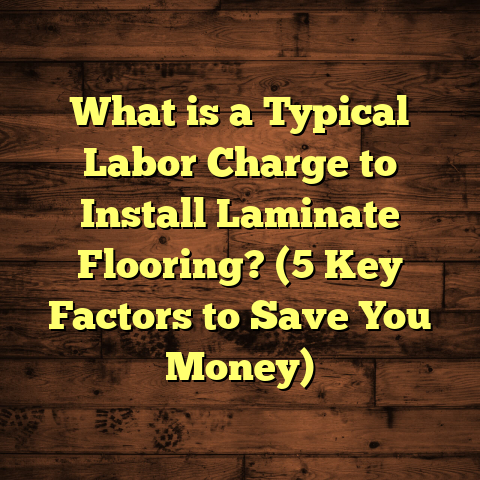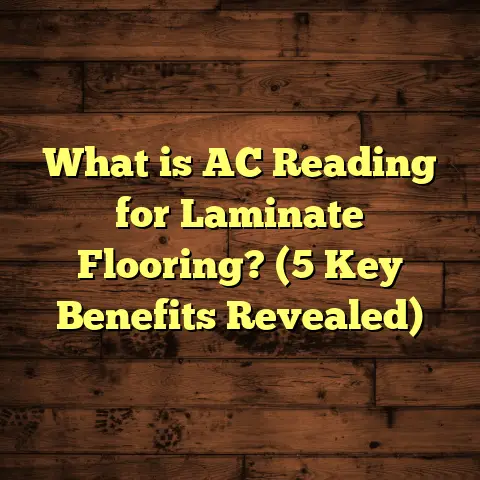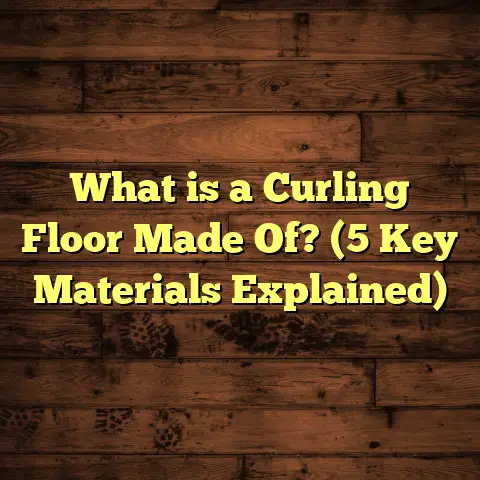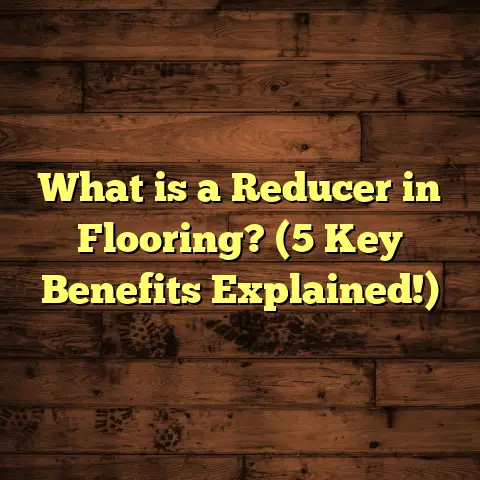What is the Cost to Epoxy a Basement Floor? (5 Factors Revealed)
Have you ever thought about turning your basement floor into a space that looks stunning, stands up
to years of wear and tear, and stays easy to clean? I remember when I first considered epoxy flooring for
my own basement. It seemed like a perfect solution, but I was curious—how much would it actually cost?
I’m guessing you’re wondering the same thing.
So, let’s talk about what goes into the price of epoxy flooring and why it can vary so much. After working
on numerous basement projects and learning from experts in the field, I can break down the numbers and
share stories that might help you figure out your own budget.
What Is Epoxy Flooring?
Before we get into costs, it’s good to understand what epoxy flooring really is.
Epoxy flooring is a coating made by mixing resin and a hardening agent. When combined and applied
to concrete floors, they form a hard, shiny layer that adheres tightly to the surface. This finish is highly
durable, resistant to stains and chemicals, and can handle heavy foot traffic or even vehicle weight in garages.
I like to think of epoxy as a super-strong skin for your basement floor. It’s not just a paint—it bonds chemically
to the concrete below, creating a surface that’s easier to clean and far more attractive than bare concrete.
Why Do People Choose Epoxy for Basements?
Basements often have unique challenges—moisture issues, cold temperatures, uneven floors, and cracks.
Epoxy does a great job sealing these problems up. It protects the floor from water damage and stains while
adding a smooth, shiny finish.
When I did my first basement floor, I wanted something that wouldn’t trap dust or mold spores
and that would brighten up the space. Epoxy gave me that polished look and resisted all the spills and dirt
that come with family gatherings or hobbies.
The 5 Factors That Affect the Cost to Epoxy a Basement Floor
Let’s get into the nitty-gritty. Your total cost depends on five major things:
- Size of your basement floor
- Condition of the concrete surface
- Type and quality of epoxy selected
- Design complexity and finish
- Labor costs and installation methods
1. Size of Your Basement Floor
This one might seem obvious: bigger basement means more cost. But the details matter.
Epoxy installers typically charge by square foot. You’ll see prices anywhere from $3 to $12 per square foot.
Why such a range? Smaller floors tend to cost more per square foot because setup fees stay the same no matter
the size. Bigger floors get cheaper per square foot due to volume discounts.
For example, my first basement was about 600 sq ft. The total cost came to $3,900 — around $6.50 per sq ft.
Later on, I helped a friend with a 1,200 sq ft basement that cost $6,000 total — only $5 per sq ft.
If you’re budgeting, measure your space accurately (length × width) and multiply by your expected cost per sq ft.
Pro tip: Don’t forget to factor in stairs or other areas you want coated separately—they add to the total area.
2. Condition of the Concrete Surface
Concrete condition can make or break your budget.
I once worked on two basements back to back: one had a clean poured concrete slab with no cracks;
the other had several large cracks and moisture seepage from outside.
For the clean slab:
- Minimal prep was needed.
- They just cleaned and etched the floor.
- Prep cost: about $0.50 per sq ft.
For the cracked floor:
- We had to grind uneven spots.
- Patch up cracks with epoxy fillers.
- Install a moisture barrier underneath.
- Prep cost shot up to $3 per sq ft or more.
Concrete prep is crucial because epoxy won’t bond properly otherwise—leading to peeling or bubbling later.
If you have moisture issues (common in basements), you might need special primers or moisture barriers.
Ignoring this can cause your epoxy floor to fail prematurely.
Here’s what I learned: Never skip a professional inspection of your concrete before pricing epoxy installation.
3. Type and Quality of Epoxy Selected
Epoxy coatings come in different formulations:
- 100% Solid Epoxy: Most durable, solvent-free, zero VOC (volatile organic compounds). Great for heavy use but costs more upfront.
- Water-based Epoxy: Less expensive but less durable; may fade or peel faster.
- Solvent-based Epoxy: Mid-range durability but stronger odor during installation.
When I installed my basement floor using 100% solid epoxy, the material alone cost around $4 per sq ft.
Cheaper water-based options were available for about $1.50-$2 per sq ft but didn’t offer the same longevity.
If you want your floor to last 10+ years without needing re-coating, solid epoxy is worth the investment.
4. Design Complexity and Finish Options
Are you thinking plain gray floor or something with flair?
Basic solid-color epoxy floors are the cheapest option. You simply roll on one or two coats of color pigment mixed with epoxy resin.
But if you want:
- Metallic finishes with swirling effects,
- Colored flakes or chips embedded for texture,
- Matte vs. high gloss finishes,
- Patterns or logos,
your price will increase significantly—sometimes by $2-$6 per sq ft depending on complexity.
I remember doing a metallic epoxy floor for a client who wanted silver and blue swirling patterns—it was stunning but added an extra $3 per sq ft on top of base costs.
5. Labor Costs and Installation Method
Labor can vary a lot depending on where you live and who you hire.
Professional installers charge between $2 and $6 per square foot on average. Some charge by the hour or flat rates.
Installing epoxy properly isn’t simple:
- You need to grind or acid-etch the concrete.
- Mix resin and hardener with exact ratios.
- Apply multiple layers carefully.
- Allow for curing time (typically 24-72 hours).
When I tried doing it myself the first time, I underestimated how precise mixing needed to be—ended up with bubbles trapped under the surface that ruined the finish!
Hiring pros saved me from costly mistakes even though it raised my upfront cost.
Real Cost Examples From My Projects
To give you some perspective, here are detailed examples based on actual jobs:
| Basement Size | Concrete Condition | Epoxy Type | Design | Labor Cost/sq ft | Total Cost |
|---|---|---|---|---|---|
| 400 sq ft | Good | Water-based | Solid color | $3 | $2,400 |
| 600 sq ft | Minor cracks | 100% solid | Solid color | $4 | $4,500 |
| 1,200 sq ft | Uneven + moisture barrier | 100% solid | Metallic finish | $5 | $12,000 |
| 900 sq ft | Good | Solvent-based | Colored flakes | $3.50 | $5,850 |
From these numbers, you can see how:
- Size dramatically impacts total cost.
- Concrete issues inflate costs through prep work.
- Higher-quality materials raise upfront costs but add durability.
- Custom designs add premium charges.
- Labor varies but is a significant portion of total price.
Additional Insights From My Experience
Over the years, I’ve learned some lessons that might help you avoid pitfalls:
Always Inspect Your Concrete First
Even if your basement looks clean, hidden cracks or moisture can sabotage epoxy adhesion.
Get a professional assessment if possible.
Prepare For Curing Time
Epoxy floors require at least 24 hours to cure enough for light foot traffic; full curing can take up to 7 days.
Don’t rush moving furniture or rugs onto fresh floors.
Consider Long-Term Durability Over Upfront Savings
Cheaper epoxy kits might save money now but may need reapplication every few years.
That adds costs and inconvenience later.
DIY—Is It Worth It?
I tried DIY once—learning curve was steep! If you’re patient with prep work and meticulous mixing, it can work for small basements or garages.
But if you want flawless results or have complex floors needing repairs, hiring pros pays off in time saved and quality guaranteed.
Diving Deeper: How Basement Size Influences Cost
Let’s explore size in more detail because it’s usually the easiest variable to measure but has hidden nuances:
Measuring Your Basement Floor Accurately
Don’t just eyeball it! Use tape measures to get precise length and width measurements of each section you want coated.
Some basements have odd shapes or separate rooms; add all areas together for your total square footage.
Why Larger Floors Can Be Cheaper Per Square Foot
Installers spread fixed costs (equipment rental, setup time) across more square footage on bigger jobs.
Materials might be bought in bulk at discount prices too.
For instance:
- A 300 sq ft floor might cost $7/sq ft because setup fees are high relative to size.
- A 1,500 sq ft floor could drop to $4/sq ft due to volume efficiencies.
Small Basement Floors Often Face Higher Minimum Charges
Many contractors have minimum charges around $1,000-$1,500 regardless of size. So very small floors might not get cheap quotes.
Concrete Surface Conditions: The Hidden Cost Driver
The better your floor’s condition going in, the less you’ll spend prepping it for epoxy.
Common Concrete Issues That Add Cost
- Cracks: Must be filled with patching compounds.
- Uneven surfaces: Require grinding or leveling.
- Moisture seepage: Needs vapor barriers or primers.
- Old sealers/paints: Must be removed thoroughly before applying epoxy.
How Prep Work Affects Cost Breakdown
In some projects I’ve seen:
- Prep can account for 30%-50% of total project cost.
- Skipping proper prep almost always leads to failure within months.
Personal Story: When Prep Saved Me From Disaster
On one job I managed, skipping moisture testing led to bubbling within weeks due to trapped dampness from groundwater seepage.
We had to redo everything at double cost—lesson learned!
Epoxy Types: What You’re Really Paying For
Understanding the types helps explain why prices vary so much:
100% Solid Epoxy
- No solvents.
- Highest durability.
- Chemical resistant.
- Expensive ($4-$8/sq ft materials only).
- Best for basements exposed to moisture and heavy use.
Water-Based Epoxy
- Contains water as solvent.
- Lower odor.
- Less durable; may yellow or peel over time.
- Cheaper ($1-$2/sq ft materials).
- Suitable for temporary solutions or light duty floors.
Solvent-Based Epoxy
- Uses organic solvents.
- Moderate durability.
- Strong odor during installation.
- Mid-range price ($2-$4/sq ft materials).
Design Options: Crafting Your Perfect Basement Floor
Epoxy lets you go beyond plain gray concrete if you want:
Solid Colors
Simple one-tone colors are cheapest and still look great in most basements.
Metallic Epoxy Finishes
These create shimmering depth effects using metallic pigments suspended in epoxy resin layers.
Costs are higher due to extra layers and skill required for application.
Colored Flakes/Chips
Small colored flakes embedded in wet epoxy add texture and slip resistance while hiding dirt well.
Typically used in garages but great in basements too.
Patterns & Logos
Custom logos or stenciled designs require extra prep and skill—this is premium work costing significantly more.
Labor Costs: Why Professional Installation Matters
Labor isn’t just slapping on paint—it requires skill and experience:
Surface Preparation Skills
Proper grinding or acid etching ensures epoxy bonds well without peeling.
Mixing & Application Precision
Incorrect mixing ratios or rushing application causes bubbles or uneven surfaces.
Safety & Ventilation Knowledge
Some epoxies release strong fumes; pros use proper ventilation equipment during installation.
Warranty & Guarantees
Reputable installers offer warranties covering defects; DIY lacks this safety net.
Maintenance & Longevity: What To Expect After Installation
Caring for your epoxy floor extends its life:
Cleaning Tips
Use mild detergents; avoid harsh chemicals or abrasive scrubbers that wear down finish.
What Causes Damage?
Heavy impact drops can chip surface; UV light (if exposed) can yellow some epoxy types over years.
Repairing Minor Damage
Small chips/cracks can be repaired with touch-up kits without replacing whole floor.
Troubleshooting Common Epoxy Flooring Problems
Even when done well, issues sometimes arise:
Peeling or Bubbling
Usually caused by poor surface prep or moisture intrusion underneath coating.
Yellowing or Discoloration
Certain epoxies exposed to sunlight over time may discolor; choose UV-resistant types for exposed areas.
Slippery Surfaces When Wet
Adding anti-slip additives like colored flakes improves traction safely.
Budget Planning Using Online Tools Like FloorTally
When I first researched costs, I found tools like FloorTally incredibly helpful—they allow you to:
- Input your basement size.
- Choose material types and finishes.
- Factor in local labor rates.
- Add waste allowances (usually 5%-10% extra material).
- Get instant cost estimates tailored to your region.
Using such tools gives you realistic budgets before calling contractors or buying supplies—saving surprises later on.
Final Thoughts From My Flooring Journey
Epoxy flooring transformed my basement from cold concrete dungeon into a clean, inviting space my family loves spending time in.
Knowing what drives cost helped me make smart choices rather than guessing blindly at prices online.
If you want a durable basement floor that looks great while protecting your home investment,
think about these factors carefully:
- Measure your space accurately.
- Get concrete inspected professionally.
- Choose quality materials suited for your needs.
- Decide if DIY or pro installation fits your skillset.
- Don’t forget design preferences affect price too!
Feel free to ask me any questions about specific products or installation tips—I’ve been through this process multiple times now!





